|
|
|
| My Favourite Planet > English > People > Hephaistos |
|
| |
Hephaistos
Ancient Greek mythology, religion and art
Hephaistos (Ἥφαιστος; Latin, Hephaestus), the son of Zeus and Hera, was the Greek god of metalworkers and sculptors, the archetypal maker of fine and extravagant metal objects, including armour for gods and heroes (e.g. Achilles, see below), Hermes' winged helmet and sandals, Aphrodite's girdle, as well as the chariot of Helios. He was also the god of fire and volcanoes, his Roman equivalent being Vulcanus.
"The bellows blew on the crucibles, twenty in all, sending forth well-blown blasts of every degree sometimes in a hurry, at other times in whatever way Hephaistos wanted and demanded. He threw weariless copper in the fire and tin and precious gold and silver; and then he set a great anvil on its block, and grasped in one hand the mighty hammer, and in the other the tongs."
Homer, Iliad, Book 18, lines 470-477.
He was even credited with the invention of bronze. Pliny the Elder alluded to this belief when discussing the decline in his time (first century AD) of the art of bronze-making:
"Formerly a mixture was made of copper fused with gold and silver, and the workmanship in this metal was considered even more valuable than the material itself; but, at the present day, it is difficult to say whether the workmanship in it, or the material, is the worst. Indeed, it is wonderful, that while the value of these [ancient] works has so infinitely increased, the reputation of the art itself is nearly extinct.
For whereas this art was ascribed to the gods themselves [i.e. Vulcanus], and men of rank in all countries endeavoured to acquire fame by the practice of it, we have now so entirely lost the method of making this valuable compound by fusion, that, for this long time past, not even chance itself has assumed, in this department, the privilege which formerly belonged to art."
Pliny the Elder, Natural History, Book 34, chapter 3. At Perseus Digital Library.
Hephaistos was worshipped at many places around the Greek world, particularly on the northern Aegean island of Lemnos (Λήμνος; Ancient Greek, Λῆμνος), on which Hephaistia (Ἡφαιστία), one of its two cities, was named after the god [1]. In Athens, where the Doric Temple of Hephaistos (the Hephaisteion, see photo below), built in the second half of the 5th century BC (around the same time as the Parthenon), stands in the Athenian Agora and is the best preserved Classical temple. It housed statues of Hephaistos and Athena who was sometimes known as Athena Ergane (the Worker), patron of crafts. The two deites were celebrated at an annual festival known as the Chalkeia (Greek for copper or bronze; chalkeus was a title for a bronzeworker), which included torch races.
"Sing, clear-voiced Muse, of Hephaestus famed for inventions. With bright-eyed Athena he taught men glorious crafts throughout the world, - men who before used to dwell in caves in the mountains like wild beasts. But now that they have learned crafts through Hephaestus the famed worker, easily they live a peaceful life in their own houses the whole year round.
Be gracious, Hephaestus, and grant me success and prosperity!"
Homeric Hymn 20, to Hephaistos [2]
Hephaistos was associated with Athena's birth: ancient vases and reliefs show him with an axe, splitting open Zeus's head, from which Athena springs fully armed (see the illustration on Athens Acropolis page 13).
Although in some myths he was said to have lived and worked on Mount Olympus, several volcanoes around the Mediterranean, especially Aetna on Sicily and the nearby Lipari islands, were believed to be locations of his fiery workshop and foundry.
In early Greek art Hephaistos was depicted as lame, sometimes as a dwarf; dwarf-like statuettes of him were placed before hearths. His lameness was the result of falling from Mount Olympus, or being thrown down soon after his birth by his mother Hera, who was enraged by his imperfect form. He refused to return to Olympus, but was eventually persuaded by Dionysus, who got him drunk, put him on a mule and led him home in a procession of Satyrs and Maenads (see photos below).
The myths concerning Hephaistos' relationship with his mother, and his return to Olympus were discussed by Pausanias, who described a painting of his return with Dionysus displayed in the sanctuary of Dionysus near the theatre in Athens:
"The oldest sanctuary of Dionysus is near the theatre. Within the precincts are two temples and two statues of Dionysus, the Eleuthereus and the one Alcamenes made of ivory and gold. There are paintings here – Dionysus bringing Hephaestus up to heaven. One of the Greek legends is that Hephaestus, when he was born, was thrown down by Hera. In revenge he sent as a gift a golden chair with invisible fetters. When Hera sat down she was held fast, and Hephaestus refused to listen to any other of the gods save Dionysus – in him he reposed the fullest trust – and after making him drunk Dionysus brought him to heaven."
Pausanias, Description of Greece, Book 1, chapter 20, section 3. At Perseus Digital Library.
Zeus married Hephaistos to Aphrodite (Ἀφροδίτη; her Roman equivalent was Venus), the irrestible goddess of love and beauty, to prevent quarrels over her between the male deities. (Aphrodite was technically either the great aunt or half-sister of Hephaistos, according to varying versions of the myths.) However, repulsed by Hephaistos' ugliness and lameness, she had many other divine and mortal lovers, notably his brother Ares (Αρης; Roman equivalent, Mars), the god of war. The jealous smith learned of her infidelity from the all-seeing sun god Helios, and used his skills to set a trap for them. When Aphrodite and Ares were in bed they were ensnared in the metal net made by Hephaistos, much to the amusement of the other Olympians.
In works of art from the 5th century BC onwards Hephaistos becomes more heroic, shown wearing a chiton (tunic), sometimes with his right shoulder bare, and often wearing a pilos (πῖλος, conical cap).
An early 5th century BC Athenian red-figured cup by the Foundry Painter, now in Berlin (Staatliche Museen, Berlin), shows Hephaistos sitting in his workshop with hammer and anvil, presenting the armour he has made for Achilles to the hero's mother Thetis (see photo below).
"And when the renowned smith, lame in both legs, had wrought all the armour, he lifted it and placed it in front of the mother of Achilles."
Homer, Iliad, Book 18, lines 614-615.
The 5th century BC Athenian sculptor Alkamenes is said to have made a statue of Hephaistos, probably for the Hephaisteion, which subtly indicated the lameness in his legs (Cicero, de natura Deorum, 1.30, 83; Valerius Maximus, 8.11, ext. 3). |
|
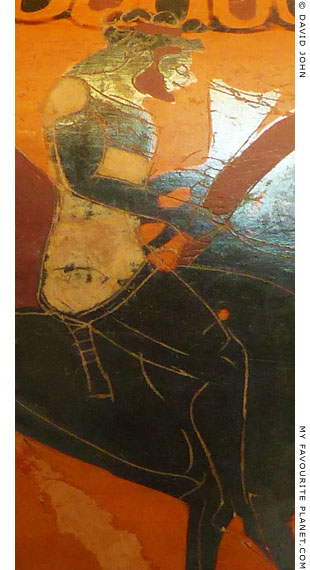
Hephaistos returning to Olympus.
Detail of a black-figure neck amphora
from southern Italy, around 520 BC.
See details below. |
|
| |
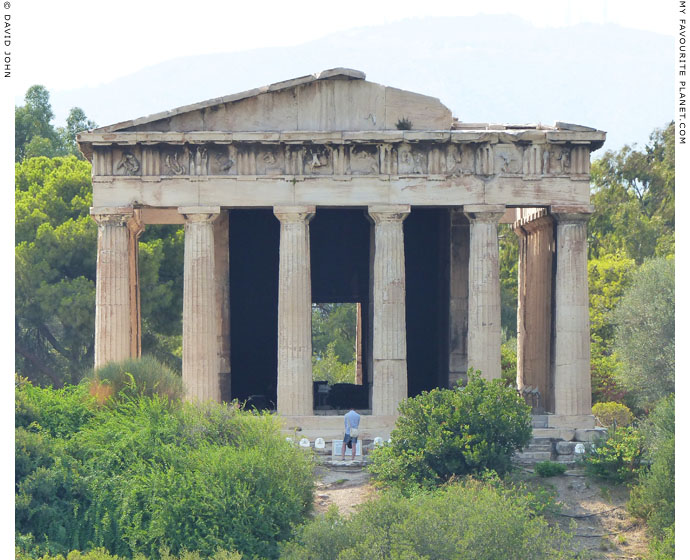
The Hephaisteion, the temple of Hephaistos and Athena Ergane, in the Agora of Athens.
Built in the second half of the 5th century BC (circa 449-415 BC), around the same time
as the Parthenon, it is the best preserved Classical temple.
|
Oriented east-west, the Doric peripteral temple on top the Agora Hill (Agoraios Kolonos hill) is 13.708 metres wide and 31.776 metres long, with six columns along the shorter east (front) and west ends and thirteen columns on each side (conventionally, the four corner columns are counted twice). It was built of Pentelic marble, and both Pentelic and Parian marble were used for its sculpted decoration. Parts of the reliefs on its continuous Ionic friezes and on some of the metopes have survived, as well as several fragments of other sculptures. The relief of the pediments may have been taken to Rome as booty.
It was previously believed to be the Theseion (temple of Theseus), and the nearby district and metro station were named Thission after it. In the Byzantine period, perhaps in the 5th - 7th century AD, it had been converted to a church dedicated to Saint George (Agios Giorgos), referred to in later documents as "Agios Giorgos Akamates". In the early 19th century a number of foreign non-Orthodox Christians were buried in the temple. After Athens became the capital of independent Greece in 1834, the building was deconsecrated, the graves were removed, and the building was used as a provisional museum and deposit for archaeological finds.
"Above the Cerameicus and the portico called the King's Portico is a temple of Hephaestus. I was not surprised that by it stands a statue of Athena, because I knew the story about Erichthonius. But when I saw that the statue of Athena had blue eyes I found out that the legend about them is Libyan. For the Libyans have a saying that the Goddess is the daughter of Poseidon and Lake Tritonis, and for this reason has blue eyes like Poseidon."
Pausanias, Description of Greece, Book 1, chapter 14, section 6. At Perseus Digital Library. |
|
|
| |
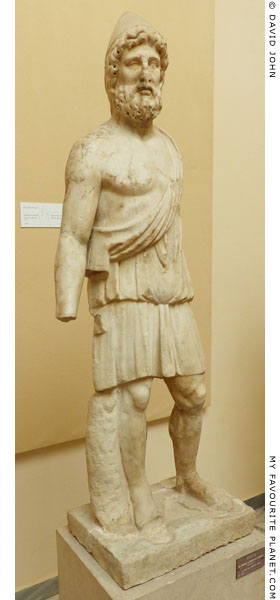 |
|
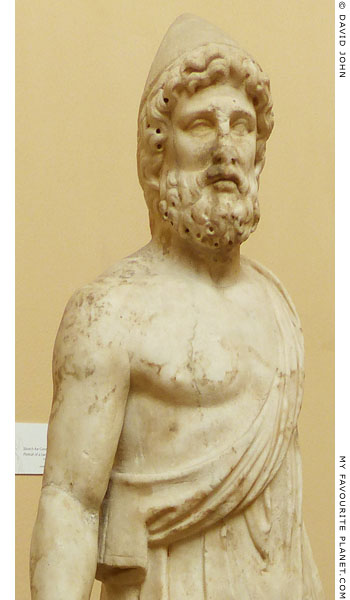 |
Marble statue identified as Vulcanus-Hephaistos.
Perhaps a copy of an original attributed to Alkamenes, 420-415 BC.
Found in the Baths of Mithras (Terme del Mitra, I,XVII,2), Ostia.
The statue lacks attributes, such as a hammer or axe, which would identify him as
Hephaistos (see a relief below). He wears a pilos (conical cap, see Medusa) and
an exomis (ἐξωμίς), a type of chiton (χιτών, tunic) fastened only at one shoulder,
leaving the other arm free. His clothing is reminiscent of depictions of Odysseus.
Ostia Archaeological Museum. Inv. No. 152. |
|
| |
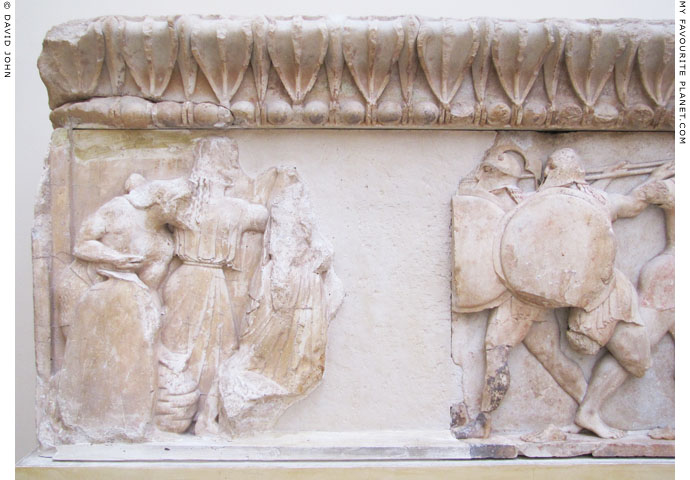
Hephaistos with two goddesses, thought to be Demeter and Persephone, on
a fragmentary Archaic relief depicting the myth of the Gigantomachy (the battle
between the Olympian gods and the Giants), from the Siphnian Treasury, Delphi.
A fragmentary slab of the left (west) end of the north frieze of the Ionic treasury,
built for the people of Siphnos around 530-525 BC (before 524 BC). Parian marble.
On the far left Hephaistos, wearing a chiton, stands at his bellows preparing fireballs
as weapons for the gods (see detail below). Next to him stand two goddesses,
dressed in long chitons, facing two Giants with Corinthian helmets, round shields
and spears, attacking them from the right.
On another fragment of the relief, part of the signature of the sculptor has
survived on the shield of a Giant, although his name is now missing. He is
referred to as "Master B", and Aristion of Paros, Boupalos of Chios and Endoios
have been suggested. See the Aristion of Paros page for further details.
Delphi Archaeological Museum, Greece. |
| |
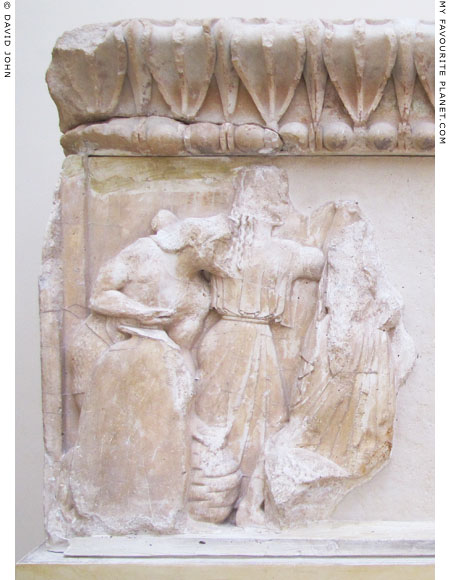
The fragment of the Gigantomachy relief from the frieze
on the north side of the Siphnian Treasury in Delphi,
depicting Hephaistos, Demeter and Persephone. |
| |
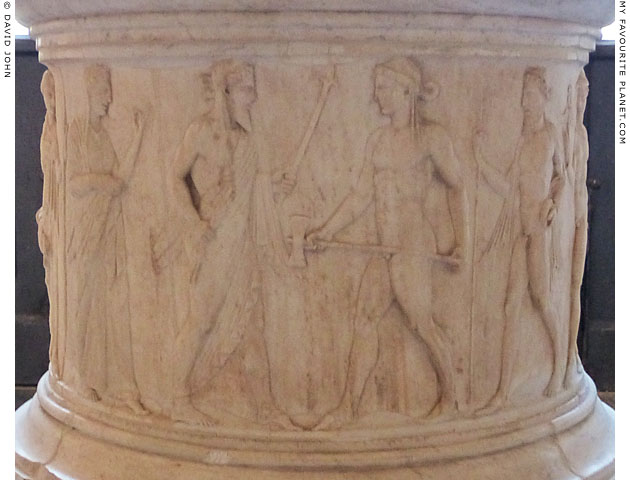
Detail of a marble puteal (well head) with an Archaistic relief depicting a procession of twelve
Olympian gods. Zeus, approaching from the left with a sceptre in his left hand and a thunderbolt
in the right, meets Hephaistos (right), who holds a double-headed axe or hammer with both hands.
Reign of Emperor Hadrian, 117-138 AD. Greek marble.
Height 83.5 cm; height of relief panel 49.3 cm.
Palazzo Nuovo, Capitoline Museums, Rome. Inv. No. MC 1919.
From the Medici Collection, then the Albani Collection.
|
The puteal is said to have been found in the 18th century in a vineyard outside the Porta del Popolo, Rome. According to other accounts it was found either at Nettuno or Hadrian's Villa, Tivoli. It then stood in the Medici Villa outside the Porta del Popolo. Cosimo III de Medici, Grand Duke of Tuscany (1642-1723) presented it to Cardinal Alessandro Albani (1692-1779). It was acquired by the Capitoline Museums in 1728 along with other objects from the Albani Collection.
Two trains of gods advance in opposite directions around the side of the puteal and meet each other. The procession approaching from the left is lead by Zeus, holding a sceptre in his left hand and a thunderbolt in his right. He is followed by Hera, Athena, Herakles, Apollo (with a lyre), Artemis (with a bow in her left hand), Ares, and Aphrodite (with a flower in each hand).
Hephaistos, approaching from the right, leads Poseidon (with trident and dolphin), Hermes (with caduceus and ram), and Hestia.
The representation has been variously interpreted as the return of Hephaestos to Olympus, the introduction of Herakles among the gods, or the birth of Athena (hence Hephaistos' axe). Not all the Twelve Great Gods of Olympus are present: Demeter is absent, as is Dionysus who is considered to have taken Hestia's place (see Dionysus). Herakles, who was not among the twelve, here makes up the number. |
|
|
| |
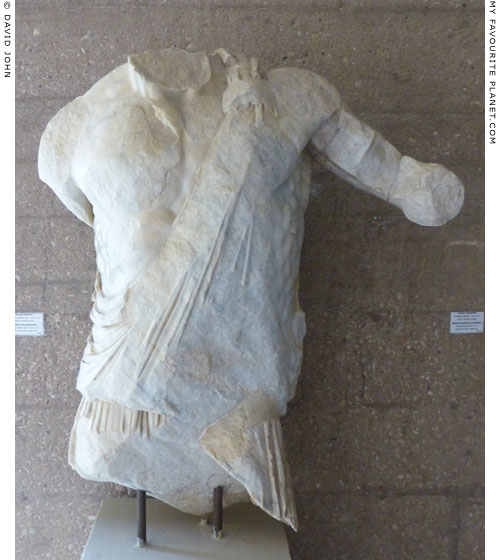
Fragmentary marble statue of Hephaistos.
Roman period, 2nd - 3rd century AD. From the
West End of the Forum of Ancient Corinth.
Corinth Archaeological Museum. Inv. No. S 790. |
| |
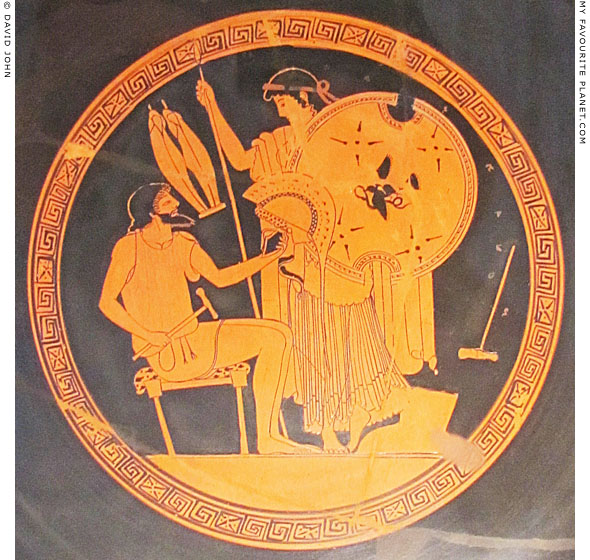
Hephaistos gives the Nereid Thetis the armour and arms he has made for
her son Achilles during the Trojan War (Homer, Iliad, Book 18, lines 614-615).
Achilles used them to avenge the death of his friend Patroklos (see Homer part 2).
The tondo on the inside of an Attic red-figure kylix (drinking cup),
made in Athens 490-480 BC. Diameter 30.5 cm.
Antikensammlung SMB, Berlin (Altes Museum). Inv. No. F 2294.
|
Known as the "Berlin Foundry Cup" (German, Erzgießerei-Schale), it is the name vase of the Foundry Painter. The outside of the cup (Sides A and B) shows sculptors at a bronze foundry.
It was discovered by Campanari in Vulci, Etruria, an important Etruscan city (Lazio, north of Rome), and acquired in 1837 for the Prussian Royal Collection, Berlin by Karl Josias Freiherr von Bunsen. It was previously kept in the Schloss Charlottenburg, Berlin.
Achilles' quarrel with Agamemnon led him to withdraw the Myrmidons from participation in the siege of Troy. However, his close companion Patrokles went into battle wearing Achilles's armour, and was killed by the Trojan prince Hektor, who took the armour as booty. Thetis persuaded Hephaistos to make new armour for Achilles, and she brought the splendid arms to him at Troy, where he wore it in the duel with Hektor.
On the kylix the bearded Hephaistos, wearing a short tunic and sitting on a cushioned stool, holds up a helmet in his left hand, and has a hammer in his right. Thetis stands to his right, wearing a cloak over a long chiton (tunic) and a fillet in her hair, and holds a spear and shield. The device on the shield is a flying bird carrying a snake in its claws, surrounded by four stars.
A pair of greaves (shin armour) hangs on the wall of the workshop, between the two figures. On the right a hammer hangs from the wall, and beneath it an anvil stands on a mound of earth. The inscription, running downwards (clockwise) to the right of Thetis, states: Ο ΠΑΙΣ ΚΑΛΟΣ (O PAIS KALOS, the boy is beautiful).
In another mythological tale, Hephaistos gave Achilles' father Peleus a sword which he used when fighting the monstrous Kalydonian Boar with Meleager, the huntress Atalanta, and other mythical heroes (see The Dioskouroi). A painting of the hunting scene was described by the sophist Philostratus the Younger (Φιλόστρατος ὁ Νεώτερος) in the 3rd century AD.
"The youths here are Meleager and Peleus, for the painting tells us that it is they who have slain the boar. ... but Peleus here holds his purple mantle out before him and he holds in his hand the sword given him by Hephaestus, as he awaits the rush of the boar; his eye is unswerving and keen of glance, and he looks as if he did not fear even to cross the borders and go with Jason on the adventure to Colchis." [3] |
|
|
| |
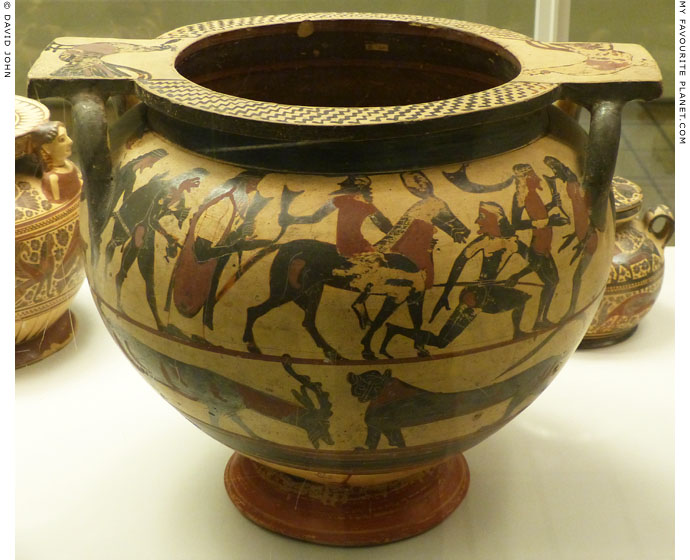
Hephaistos returns to Olympus on a mule, escorted
by Dionysus (behind Hephaistos) and his companions.
Middle Corinthian column krater (bowl for mixing wine and water), about
600-575 BC. Perhaps by the Ophelandros Painter. From Nola, Campania, Italy.
Hephaistos, Dionysus and two other figures hold drinking horns.
Some of the dancers wear padded costumes which may suggest
that the scene depicts a ritual or dramatic performance.
Such carefree Archaic period depictions of the rustic procession
may be compared with the more sophisticated and consciously
triumphal Roman period images of Dionysus' return fom India.
British Museum. Inv. No. GR 1867.5-8.860 (Vase B 42). Blacas Collection. |
| |
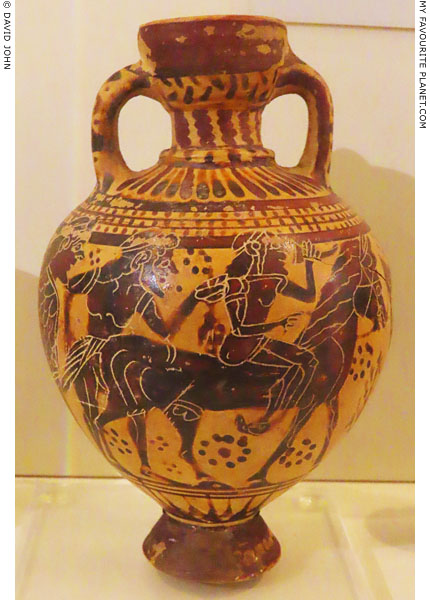
Hephaistos returns to Mount Olympus on a horse (?),
raising a drinking horn to his lips.
Middle Corinthian black-figure amphoriskos (small amphora),
about 600-575 BC. Provenance unknown. Height 115 cm.
National Archaeological Museum, Athens. Inv. No. 664. |
| |
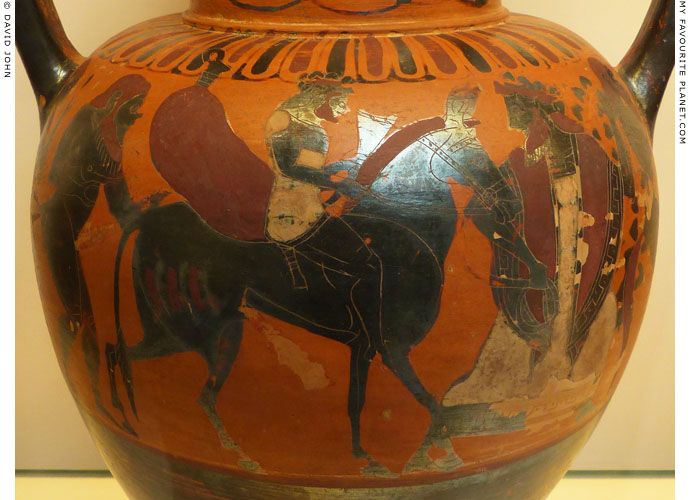
Dionysus leads Hephaistos, riding a mule, back to Olympus, followed by a Silen [4].
Black-figure neck amphora made in southern Italy around 520 BC.
A "Pseudo-Chalcidian" vase attributed to the Polyphemos Group.
British Museum. Inv. No. GR 1949.2-17.1. |
| |
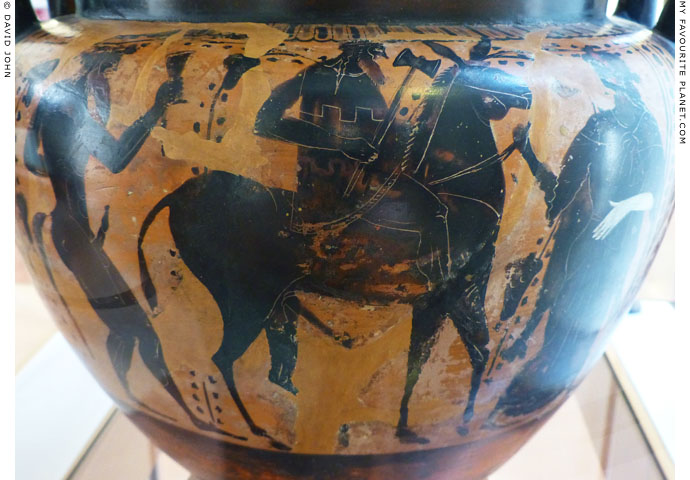
Detail of an Attic column krater showing Hephaistos returning to Olympus.
Attributed to the Leagros Group, second half of the 6th century BC.
From Akragas (Agrigento), Sicily.
Hephaistos, wearing a crown and craftman's tunic (exomis), and
holding an axe or hammer, rides an ithyphallic mule led by Maenad.
Behind him is a Satyr with an erect penis holding a rhyton (drinking
horn). The other side (Side B) shows the rape of Thetis by Peleus.
Agrigento Regional Archaeological Museum. Inv. No. C.1535. |
 |
|
|
| |
| |
 |
| |
 |
| |
 |
| |
 |
| |
 |
| |
 |
| |
George Alvanos
rooms in
Kavala's historic Panagia District
Anthemiou 35,
Kavala, Greece
kavalarooms.gr
|
| |
Olive Garden Restaurant
Kastellorizo,
Greece
+30 22460 49 109
kastellorizo.de
|
| |
Papoutsis
Travel Agency
Kastellorizo,
Greece
+30 22460 49 286
greeklodgings.gr
|
| |
| |
| |
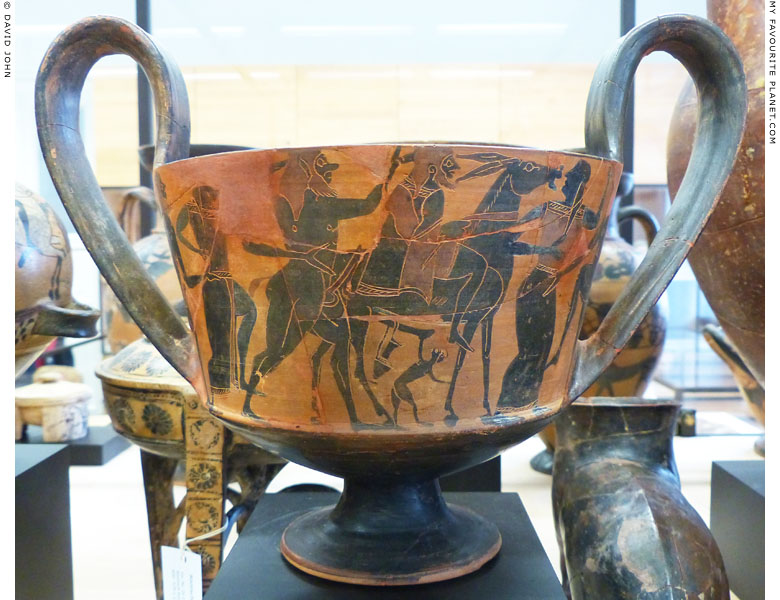
A large Attic black-figure kantharos (drinking cup) with a depiction of Hephaistos
returning to Olympus. He wears a short mantle and rides an ithyphallic mule
which has an oinochoe (οἰνοχόη, wine jug) hanging from its phallus. He is
escorted by Satyrs, Maenads and a small figure (a child?) beneath the mule.
575-525 BC.
Studiendepot Antike, Skulpturensammlung, Albertinum, Dresden. Inv. No. ZV 1466. |
| |
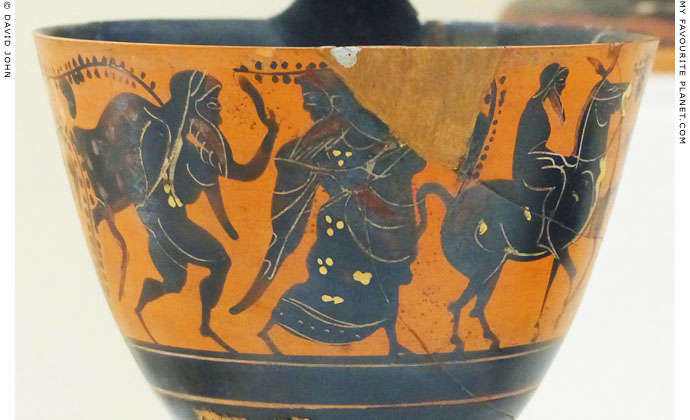
Detail of a black figure kyathos (cup) showing Hephaistos' return to Olympus
on a mule. Dionysus and a Satyr carring a sack of wine follow him. 520-500 BC.
Excavated at tomb in Room 371, Banditaccia necropolis, Etruria.
National Etruscan Museum, Villa Giulia, Rome. |
| |
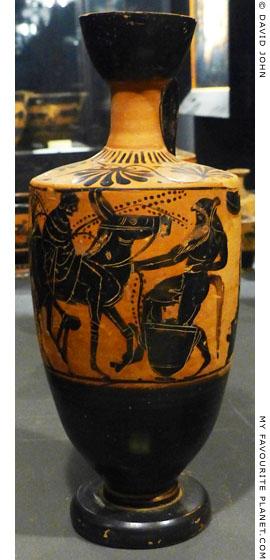 |
|
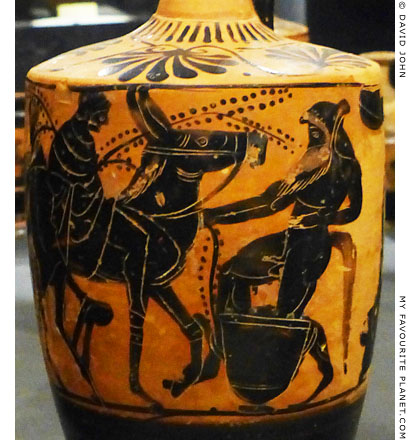 |
Hephaistos returns to Olympus on an ithyphallic mule led by a Satyr.
Attic black-figure lekythos, made in Athens, end of the 6th century BC.
Museo Civico, Castello Ursino, Catania, Sicily.
Inv. No. 5069. From the Benedettini Collection. |
|
| |
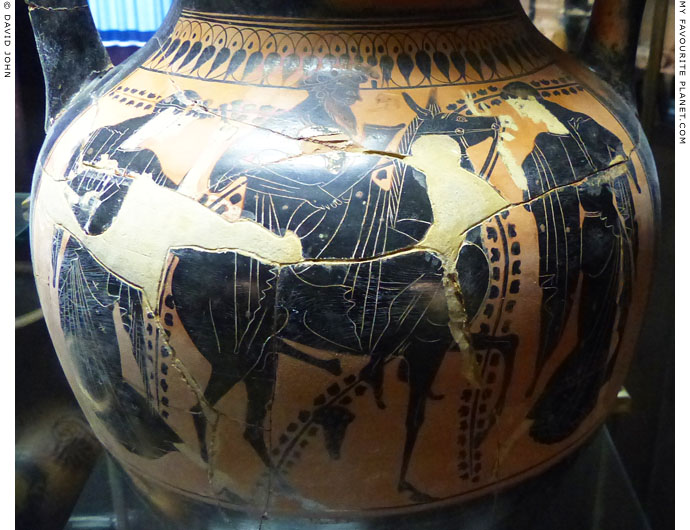
A beaded god on an ithyphallic mule, holding a large rhyton (drinking horn), with a dancing
Maenad on either side. Described by the museum labelling as a "dionysiac scene with the god
[i.e. Dionysus] on a mule", the deity may be Dionysus or Hephaistos returning to Olympus.
Detail of an Attic black-figure amphora, made in Athens, end of the 6th century BC.
Found in a small ceramic sarcophagus, Tomb 13, Cemetery Lombartolo, the
Necropolis at Capo Soprano, Gela, Sicily.
Paolo Orsi Regional Archaeological Museum, Syracuse. Inv. No. 21948. |
| |
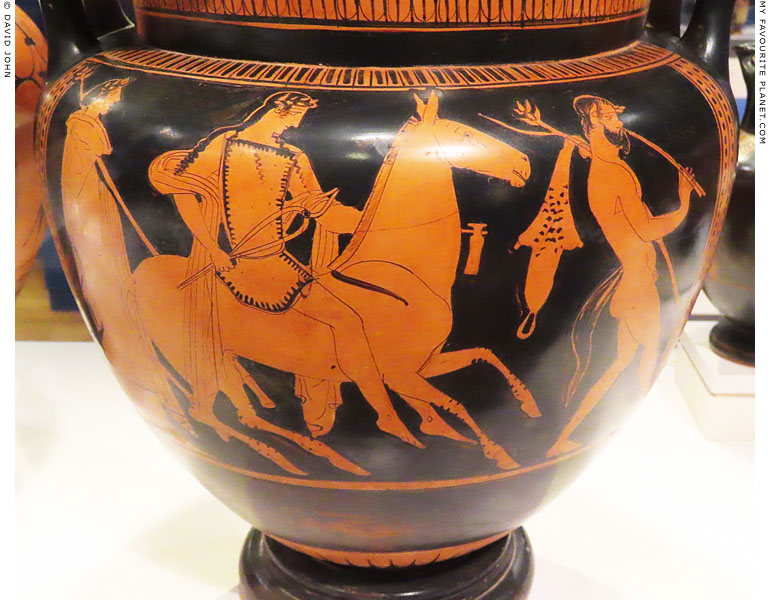
Hephaistos, shown as youthful and clean-shaven, returns to Olympus, advancing to the right
on an ithyphallic mule, led by a Satyr and followed by a Maenad. He appears elegantly groomed,
with long, coiffured hair, wearing a wreath, a short chiton (tunic) and a himation (cloak) draped
over his arms. As usual, he is depicted barefoot. He carries metalworking tongs in his right hand,
and in his extended left hand is what appears to be a vessel on a pole (it has been suggested
that it is a hammer). The Satyr, naked apart from a wreath, walks in front, with shaggy hair and
beard, pointed ears and a horse's tail. He plays an aulos, and over his left shoulder he carries
a wineskin, which hangs from a branch or thyrsos. The Maenad is also wreathed, is wrapped
in a himation and carries a thyrsos over her left shoulder.
Detail of an Attic red-figure column krater, made in Athens around 440-430 BC.
Painted by a later Mannerist, it is similar to the work of the Hephaistos Painter.
Height 39.5 cm, diameter of mouth 33.6 cm, diameter of foot 16.4 cm.
Side B shows a woman standing between two draped youths, one holding a staff.
Rijksmuseum van Oudheden, Leiden, Netherlands. Inv. No. I 1970/4.1. |
| |
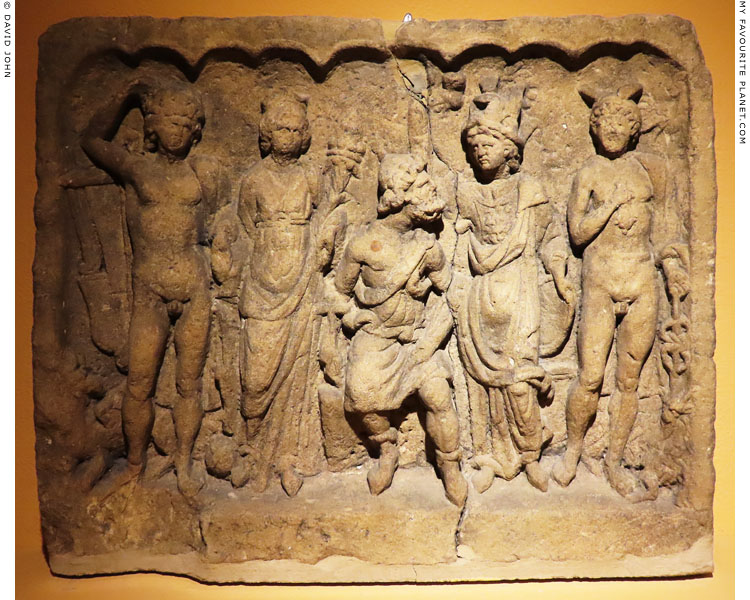
The "Fünfgötter Relief", a sandstone votive relief depicting Vulcanus (Hepahaistos) in a group
of five gods (left - right): Apollo, Fortuna (Tyche), Minerva (Athena) and Mercury (Hermes).
Roman period, around 215 AD. From Rheinzabern (ancient Rhenanae Tabernae, Germania
Superior), Kreis Germersheim, Germany. Height 48 cm, width 61 cm, depth 9.5 cm.
Historisches Museum der Pfalz, Speyer, Germany. Inv. No. 79.
|
The relief appears to show the return of Hephaistos to Olympus. He sits in the centre of the group, his head turned to the right, and wears a pilos and an exomis (as on the statue in Ostia above), as well as boots. In his left hand he holds long blacksmith's tongs, and has a hammer in his right hand which rests on an ambos.
On the far left stands the nude figure of Apollo, with a himation (cloak) over his left shoulder and his right hand on top of his head (as in Lycean Apollo and Apollo Kitharoidos type statues). He appears to be holding an object in his left hand. Behind him is a kithara (a large lyre), apparently hanging on a wall, and below it a crouching Gryphon, its head turned around to face right. Next to him stands Fortuna (Tyche), who may be wearing a mural crown. She cradles a cornucopia in her left arm, and in her right hand she holds a ship's rudder which rests on a globe.
Next, after Vulcanus, stands Minerva (Athena), wearing a helmet, the aegis and Gorgoneion (see Medusa) on her breast, and a himation (cloak) wrapped around her body over a long chiton (tunic). She holds a spear in her right hand and a small round shield in her left hand. To the left of her head is her owl (see Athens Acropolis page 29). The pose of the goddess, her shield, spear and decorated helmet (the details of which are now difficult to make out), may be in imitaton of the statue of Athena Parthenos by Pheidias (see Athens Acropolis page 13).
On the far right stands Mercury (Hermes), naked except for a winged cap. He holds a purse in his right hand, and in his left hand he holds his caduceus (kerykeion) which appears to be resting on the head of a male goat (see two other Roman reliefs of Mercury from the Pfalz on the Hermes page).
The Historisches Museum in Speyer has a number of large reliefs like this (see another below), found at sites of Roman settlements and military posts in the Pfalz area, west of the River Rhine. Like this one, the quality of the workmanship is not the best, but it is evident that their makers were skilled and well-versed in the iconography of classical sculpture. It is often tempting to identify well-known statues in works in other media, but the figures in this relief do resemble ancient statues of the respective deities now in various museums around the world (some which can be seen on the pages of this website).
See also a Roman relief from Speyer depicting one of the Dioskouroi. |
|
| |
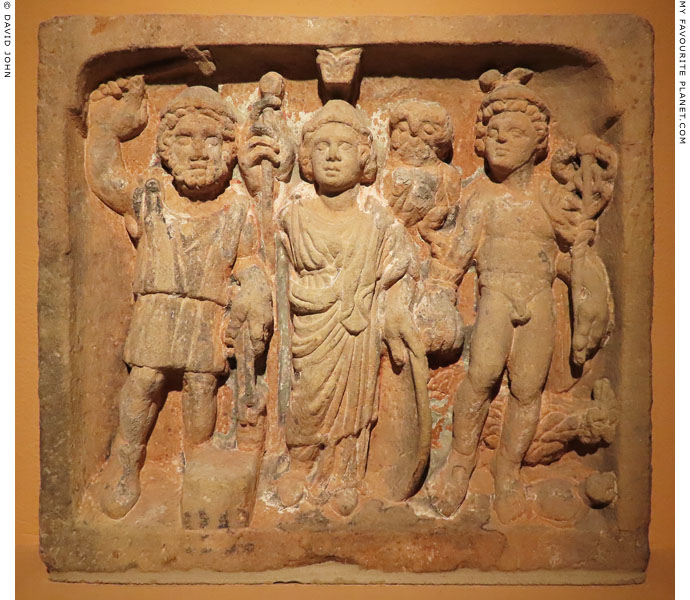
A relief depicting Vulcanus (Hepahaistos) with Minerva (Athena) and Mercury (Hermes).
Perhaps Roman period, or a 19th century fake. From Rheinzabern (ancient Rhenanae Tabernae,
Germania Superior), Kreis Germersheim, Germany. Height 42 cm, width 47.5 cm, depth 8 cm.
Historisches Museum der Pfalz, Speyer, Germany.
|
During the 19th century Rheinzabern became famous for the large quantity of archaeological objects diecovered there, which led to a demand for Roman antiquities. Johann Michael Kaufmann (1791-1861), a local stonemason, had innumerable forgeries made to supply the demand and sold them to museums in Germany and abroad. Remarkably, experts can still not tell for certain whether this relief is a forgery, perhaps based on the relief of the five gods above, and do not know how the objects were made. If it is a fake the maker was very cunning and artful in creating a work which captures exactly the mix of gaucheness and intensity evident in similar Roman provincial reliefs.
All three figures have disproportionately large hands. This in itself is not necessarily a sign of a clumsy forgery, since other Roman reliefs also show this anomaly (see, for example, a relief of Mercury in Varna, Bulgaria). Vulcanus (Hepahaistos) stands on the left, wearing a pilos, a short-sleeved chiton (tunic) and boots. In his left hand he holds tongs resting on an ambos which stands on a square base, and in his raised right hand he holds a hammer.
As in the "Fünfgötter Relief" above, Minerva (Athena), who stands in the centre of the group, wears a helmet, himation and long chiton, and holds a spear and shield. If anything she resembles even more the extant replicas of the Athena Parthenos statue, particularly in the pose and the position and size of the shield. Behind her left shoulder is Athena's owl. On the right Mercury is naked except for a winged cap and a himation over his left shoulder, and holds a purse and a caduceus. Behind his legs is a large cockerel, and near his left foot is what appears to be a tortoise. |
|
| |
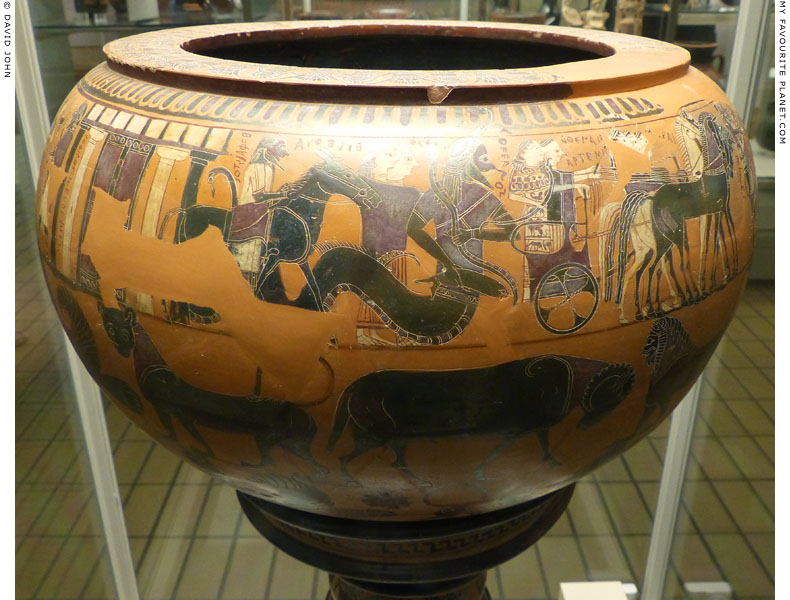
A large inscribed Attic black-figure dinos (wine bowl) with a depiction
of a procession of deities attending the wedding of Peleus and Thetis.
Made in Athens around 580-570 BC. Height of dinos 71 cm. Signed by Sophilos
as painter, the earliest known Athenian vase painter to sign his works.
ΣΟΦΙΛΟΣ [...] ΜΕΓΡΑΦΣΕΝ (Sophilos drew me)
British Museum. Inv. No. 1971,1101.1.
|
Both Zeus and Poseidon were attracted to the sea nymph Thetis (Θέτις), but then learned that her son was destined to be greater than his father. So it was decided that she should marry the mortal Peleus (Πηλεύς), and all the Olympian gods attended the wedding near the cave of the Centaur Cheiron (see Homer part 2) on Mount Pelion (Πήλιον) in Thessaly. It is notable that neither Zeus nor Poseidon, or their respective wives Hera and Amphitrite, are depicted on the dinos.
The procession scene runs continually right around the body of the vessel, beginning and ending with the house of the bridegroom Peleus, between two columns of which is written "Sophilos drew me". The names of the participants in the procession are painted next to the figures.
The line of wedding guests is led by Iris, who is greeted by Peleus, standing before his house, holding a kantharos (wine jug). Next to arrive are Demeter, Hestia, Chariklo, Leto, Dionysus and Hebe. Then comes Cheiron, who was to be the guardian and tutor of Achilles, the future son of Peleus and Thetis. Behind him walk Themis and three nymphs, followed by three four-horse chariots: Ares and Aphrodite accompanied by five muses, one playing a syrinx (Pan pipes); Hermes and Apollo accompanied by three muses; Athena and Artemis accompanied by three Moirai (Fates). At the rear are Okeanos, Tephys, Eileithyeia and Hephaistos (see photo below), behind whom can be seen the columns of Peleus' house.
Remarkably, the stand of the dinos has also survived. Its foot and the lower part of the bowl are decorated with paintings of lions, deer, goats, rams, a wild boar and sirens. Bowls and stands of this shape are thought to have derived from eastern metal prototypes. It has been suggested that this vessel may have been designed for a wedding feast.
The wedding procession is also depicted on the "François Vase", a large inscribed Attic black-figure volute krater, circa 570-560 BC, signed by the painter Kleitias (Κλειτίας) and the potter (Ergotimos Ἐργότιμος). Among the 270 painted subjects (with 121 inscriptions) on the vase, depicting mythological scenes and figures, is also the processional return of Hephaestus to Olympus. National Archaeological Museum, Florence. Inv. No. 4209.
See also: the Judgement of Paris |
|
| |
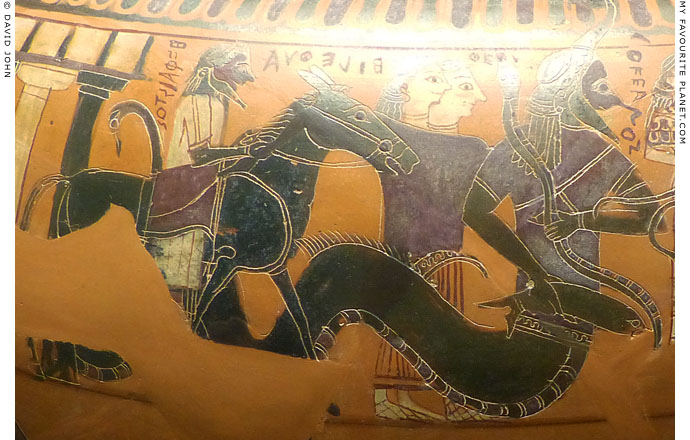
Detail of the dinos above.
Hephaistos, left, riding a mule, at the rear of a procession of deities, nymphs and muses
at the wedding of Peleus and Thetis. Before him are Eileithyeia, goddess of childbirth,
with Tephys, and her husband, the fish-tailed god Okeanos, the grandfather of Thetis. |
| |
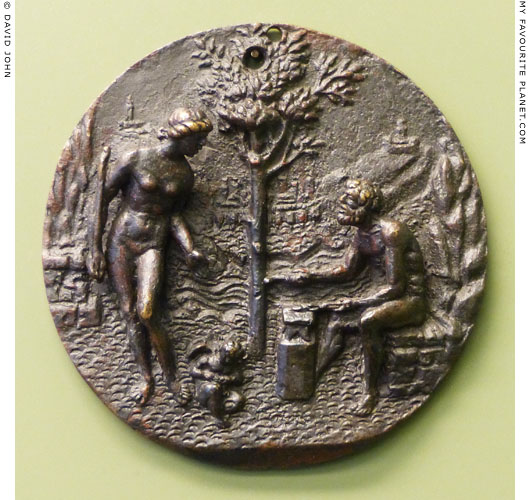
Bronze plaque with a relief of Hephaistos (Vulcan)
forging arrows for Eros (Cupid), watched by Aphrodite.
Made by Andrea Briosco, known as Riccio, Padua,
late 15th - early 16th century. On the back, the
inscription "Ri", was cast with the plaque.
Bode Museum, Berlin. Inv. No. 1921. Acquired 1892. |
| |
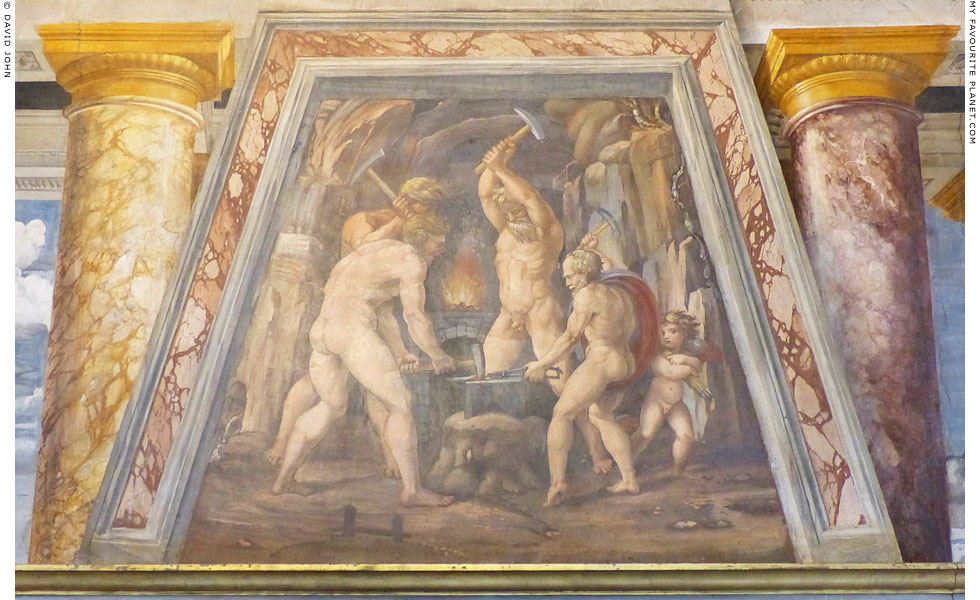
Vulcan's forge (La Fucina di Vulcano), a fresco painted 1517-1519 (or perhaps later) by the Sienese
painter and architect Baldassare Peruzzi (1481-1536) on a panel on the chimney breast above the
fireplace in the Perspectives Hall (la Sala delle Prospettive) in the Villa Farnesina, Trastevere, Rome.
On the wall either side of the panel are trompe l'oeil frescoes of monumental architecture.
For further information about the Villa Farnesina, see Aetion. |
| |
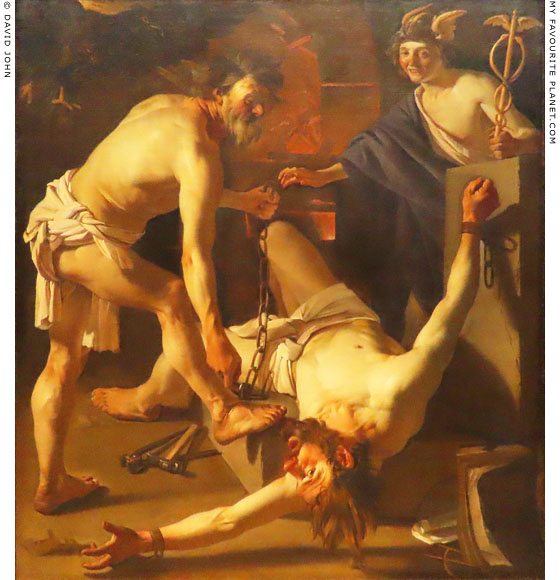
Prometheus door Vulcanus geketend (Prometheus being chained by Vulcan)
by Dirck van Barburen (circa 1595-1624). Oil on canvas, 1623.
Prometheus was punished by Zeus for stealing fire from the gods and giving it to mankind.
(Vulcan) Hephaistos chained him to a rock where an eagle pecked out his liver. Here Mercury
(Hermes) witnesses the punishment being inflicted, which appears to amuse him. The dramatic
lighting and the sunburned face and hands of the figures are borrowed from Caravaggio.
Rijksmuseum, Amsterdam. Inv. No. SK-A-1606. Donated by J. von Loehr, Cairo, 1893. |
| |
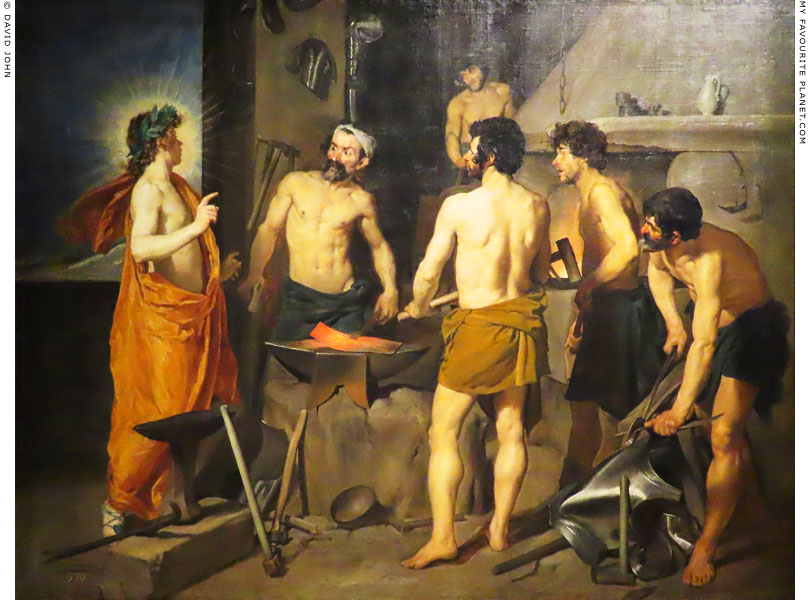
La fragua de Vulcano (Vulcan's forge) by Diego Velázsquez (1599-1660). Oil on canvas, 1630.
Museo Nacional del Prado, Madrid. Inv. No. 1171.
Exhibited in the Rijksmuseum, Amsterdam during the exhibition
Rembrandt - Velázsquez, Dutch and Spanish masters, 2019-2020. |
| |
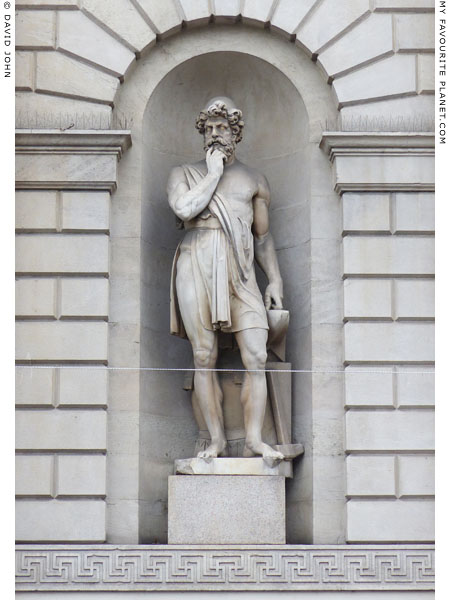
A modern statue of Vulcan by Democrito Gandolfi (1797-1874)
on the north side of the west tower of Porta Venezia, Milan.
|
The Porta Venezia stands on the site of an ancient gate of the Roman city Mediolanum (Milan). Rebuilt a number of times and known by various names, including Porta Orientale and Porta Renza, the present monumental neoclassical gateway is based on an initial design Giuseppe Piermarini (1734-1808), whose work was continued after his death by his student Luigi Cagnola (1762-1833). Consisting of two massive sandstone towers on either side of the road, each with Doric porticos (with Tuscan columns) on three of the fours sides, it was completed 1827-1828.
The neoclassical reliefs depicting historical scenes and statues of Roman gods, sculpted by a number of Italian artists, were added in 1833. The statues on the west side: Mercury (Hermes), Vulcan (Hephaistos), Abundantia (Abundance) and Justitia (Lady Justice). The statues on the east side: Minerva (Athena), Ceres (Demeter), Eternita (Eternity) and Fedelta (Fidelity).
Vulcan is depicted with his right hand on his bearded chin, as if contemplating his next masterpiece. Identified in Roman culture not only with metalwork but also with industry in general, the muscular and dignified deity, showing no sign of lameness, thinks only of his next commission. He wears the pilos (conical hat) and partly discarded chiton, his left arm leaning on an anvil over a large hammer. A newly-finished cuirass can be seen between his legs. The generality of the flattened anvil, hammer and cuirass are tedious, but the figure of Vulcan is wonderfully evocative, and, like the other statues on the Porta Venezia, attempt to summarize the power and fascination of the allegorical depictions of the ancient deities. |
|
| |
| Hephaistos |
Notes, references and links |
 |
|
1. Hephaistos and Lemnos
Lemnos was said to have originally been inhabited by the Tyrsenoi, associated by ancient authors with the Etruscans. Later Pelasgians (pre-Greek natives of Greece) who had been driven from Athens took over the island. The city of Hephaistia, at the north of the island, was first mentioned by Herodotus. Some time between 515 and 495 BC the Athenian Miltiades son of Kimon (Μιλτιάδης ὁ Κίμωνος, also referred to as Miltiades the Younger, circa 550-489 BC), then tyrant of the Thracian Chersonese, took Lemnos from the Pelasgians, claiming to be fulfilling an oracle. He later gave the island to Athens, and although it was briefly occupied by the Persians, the Athenians sent settlers there in the mid fifth century BC.
"... he [Miltiades] proclaimed that the Pelasgians must leave their island, reminding them of the oracle which the Pelasgians thought would never be fulfilled. The Hephaestians obeyed, but the Myrinaeans would not agree that the Chersonese was Attica and were besieged, until they too submitted. Thus did Miltiades and the Athenians take possession of Lemnos."
Herodotus, Histories, Book 6, chapter 140. At Perseus Digital Library.
It is thought that the sculptor Alkmenes may have been from Lemnos.
Around 450-440 BC the colonists on Lemnos dedicated a bronze statue of Athena known as "the Lemnia" by Pheidias on the Athenian Acropolis.
"There are two other offerings [on the Acropolis], a statue of Pericles, the son of Xanthippus, and the best worth seeing of the works of Pheidias, the statue of Athena called Lemnian after those who dedicated it."
Pausanias, Description of Greece, Book 1, chapter 28, section 2. At Perseus Digital Library.
2. Homeric Hymn 20, to Hephaistos
Homeric Hymn 20 to Hephaestus, in: Hugh G. Evelyn-White (translator), The Homeric Hymns and Homerica. Harvard University Press, Cambridge, MA., and William Heinemann Ltd., London, 1914. At Perseus Digital Library.
3. Philostratus the Younger on Meleager and Peleus
Philostratus the Younger, Imagines, No. 3, Meleager. In: Philostratus The Elder Imagines, Philostratus The Younger Imagines, Callistratus Descriptions, pages 356-361. Loeb Classical Library edition L256, in Greek with an English translation by Arthur Fairbanks. William Heinemann Ltd, London and G. P. Putnam's Sons, New York, 1931. At the Internet Archive.
4. Silens and Satyrs
See a short discussion on the differences between Silens, Satyrs and other members of Dionysus' thiasos (retinue) in ancient Greek and Roman art on the Dionysus page. |
|
|
| |
Photos on this page were taken during
visits to the following museums:
Germany
Berlin, Altes Museum
Berlin, Bode Museum
Dresden, Albertinum, Skulpturensammlung
Speyer, Historisches Museum der Pfalz
Greece
Athens, Ancient Agora archaeological site
Corinth Archaeological Museum
Delphi Archaeological Museum
Thebes Archaeological Museum
Italy
Ostia Archaeological Museum
Rome, Capitoline Museums, Palazzo Nuovo
Rome, National Etruscan Museum, Villa Giulia
Rome, Villa Farnesina
Italy - Sicily
Agrigento Regional Archaeological Museum
Catania, Museo Civico, Castello Ursino
Syracuse, Paolo Orsi Regional Archaeological Museum
Netherlands
Amsterdam, Rijksmuseum
Leiden, Rijksmuseum van Oudheden
United Kingdom
London, British Museum
Many thanks to the staff of these museums. |
|
| Photos and articles © David John, except where otherwise specified. |
 |
Visit the My Favourite Planet Group on Facebook.
Join the group, write a message or comment,
post photos and videos, start a discussion... |
|
|
| |
| Copyright © 2003-2025 My Favourite Planet | contributors | impressum | contents | sitemap |
| |





































